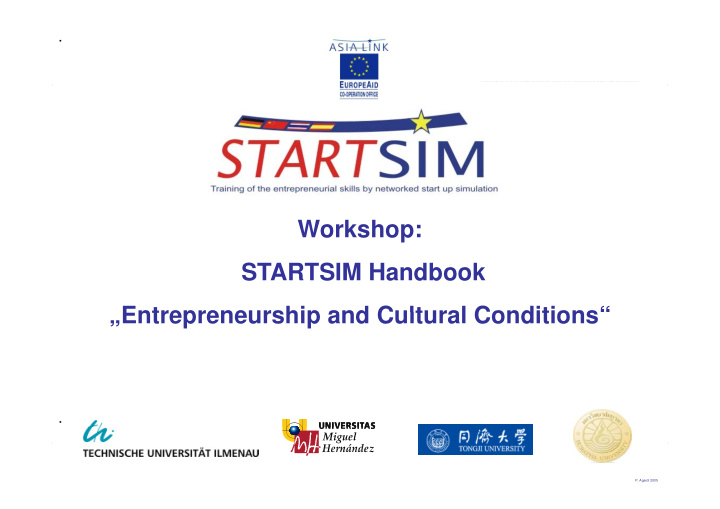



. Workshop: STARTSIM Handbook „Entrepreneurship and Cultural Conditions“ Entrepreneurship and Cultural Conditions“ . F. Heintze and J. Moelleken, 2008 P. Agardi 2005
STARTSIM Handbook Introduction: Overview about STARTSIM project (TU Ilmenau) Chapter 1: General conditions for entrepreneurial activities (Tongji) Chapter 2: Business creation across cultures (UMH de Elche) Chapter 3: Business plan (Burapha University) Chapter 4: Business Simulation in entrepreneurship education (TU) F. Heintze and J. Moelleken, 2008
Introduction: Overview about STARTSIM project (TU Ilmenau) ( ) 1. Context for STARTSIM proposal’s development p p p 2. Objectives 3 3. Partners Partners 3. Methodology 4. 4 Implementation and Realization Implementation and Realization 5. Expected results and outputs 6 6. P Presentation of STARTSIM handbook’s content t ti f STARTSIM h db k’ t t F. Heintze and J. Moelleken, 2008
Chapter 1: General conditions for entrepreneurial activities (Tongji) Section 1 Introduction Section 2 Overview of entrepreneurial conditions for entrepreneurial activities activities Section 3 Political-legal Environment in Four Countries Chapter 1 Political-legal Environment in China Chapter 2 Political-legal Environment in Thailand Chapter 3 Political-legal Environment in Germany Chapter 4 Political legal Environment in Spain Chapter 4 Political-legal Environment in Spain Section 4 Economic Environment in Four Countries Chapter 5 Profiles of countries p Chapter 6 Comparisons of Economic indicators Chapter 7 Comparison of Technological indicators Section 5 Conclusion F. Heintze and J. Moelleken, 2008
Chapter 2: Business creation across cultures (UMH de Elche) 1. Introduction 2. Overview of Socio-Culture Factors and Entrepreneurship 3 3. Entrepreneurial activity: monitoring differences between countries Entrepreneurial activity: monitoring differences between countries 3.1 Entrepreneurial activity 3.2 Association between entrepreneurship and the level of economic development 3.3 Entrepreneurial Behavior 3.4 Motivation: Opportunity and Necessity Motives 3.5 Gender 3.6 Age Distribution of Entrepreneurs 3 7 3.7 Population related to entrepreneurship perception’s Population related to entrepreneurship perception s 4. Entrepreneurial framework conditions 4.1 Starting a Business 4.2 Dealing with Licenses 4.3 Employing Workers 4.4 Registering Property 4.5 Getting Credit 4.6 4 6 Protecting Investors Protecting Investors 4.7 Paying Taxes 4.8 Trading Across Borders 4.9 Enforcing Contracts 4.10 Closing a Business F. Heintze and J. Moelleken, 2008
Chapter 3: Business plan (Burapha University) I.INTRODUCTION ( Vuttichat Soonthonsmai) II BUSINESS PLAN CONTENT II. BUSINESS PLAN CONTENT Part 1 Environmental Scanning ( Supichayangkool) Part 2 Current Strategic Posture and Processes ( Soonthonsmai) III Using and implementing the business plan (Nontasak) III. Using and implementing the business plan (Nontasak) IV. Evaluation V. Business Plan Presentation F. Heintze and J. Moelleken, 2008
Chapter 4: Business Simulation in entrepreneurship education (TU) 1. Introduction 2. Entrepreneurship and Universities 3 3. Entrepreneurship Education and teaching methods Entrepreneurship Education and teaching methods 3.1 Significance and Historical Perspective 3.2 Definitions 3.3 Teaching methods 4. The STARTSIM concept 5. Experiences of working with STARTSIM 6. Measurement and empirical evaluation 7 7. Conclusion Conclusion F. Heintze and J. Moelleken, 2008
• • Introduction: Overview about STARTSIM project Introduction: Overview about STARTSIM project (TU Ilmenau) (TU Ilmenau) • P Part 1: General conditions for entrepreneurial activities (Tongji) t 1 G l diti f t i l ti iti (T ji) – Chapter 1: • 1.1. – 1.1.1. 1 1 1 • Part 2: Business creation across cultures (UMH de Elche) • Part 3: Business plan (Burapha University) • Part 4: Business Simulation in entrepreneurship education (TU) F. Heintze and J. Moelleken, 2008
Recommend
More recommend